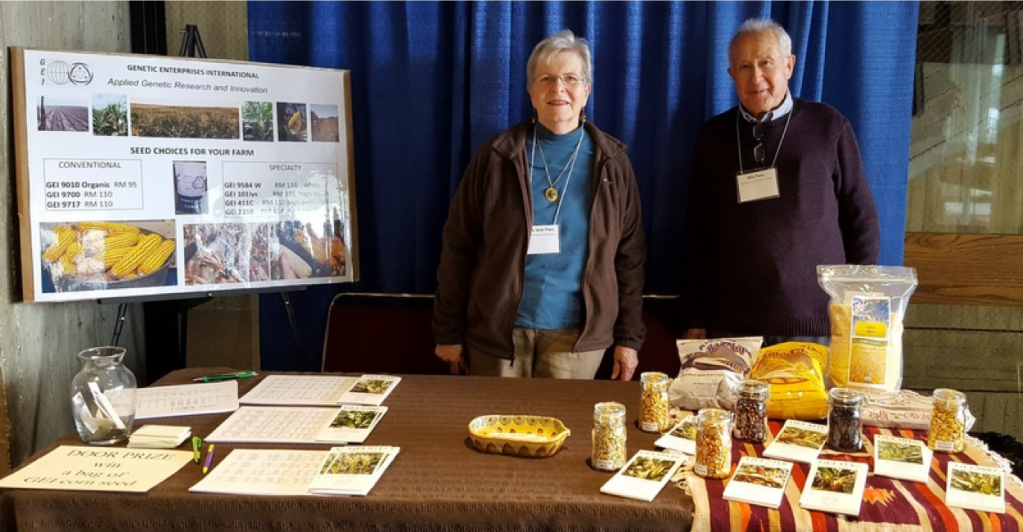Practical Farmers of Iowa Conference

This past weekend, we participated in the Practical Farmers of Iowa Annual Conference . We were one of about 75 exhibitors. On our table, we featured jars of grain of GEI specialty hybrids, their respective brochures and products made from some of the specialties. We also had brochures and yield data for GEI conventional and organic hybrids that are available. We had the chance to visit with some of our old friends along with the opportunity to make new friends.
The colorful display of unique grains attracted attention. We had Papa’s blue corn meal made from GEI 411C and Early Morning Harvest’s corn grits made from GEI 2318 (high carotene) corn. The distinctive bags of Whole Grain Milling High Lysine Corn Tortilla Chips and also Blue Corn Tortilla Chips brought people to our table. One comment was, “Those are the BEST chips…I wish I could find them closer to home” (He wanted some place in the Decorah area to buy them).
The winner of our door prize, a free bag of GEI 9700, was Bill Frederick of Jefferson, Iowa.

A reoccurring theme with speakers and exhibitors seemed to be improving soil health, plant health, animal health and consumer health. There were 40 breakout sessions that were well attended. The nutritional value of GEI specialties was well noted. A veterinarian from the Manchester, Iowa area was pleased to see the value added nutrition of GEI specialties plus the fact that the hybrids are non GMO. One customer told us about a neighbor raising rabbits for meat. Their feed was made with elevator corn with GMO and the rabbits were dying from bloat. By switching the feed to high lysine GEI 101 lys, the problem disappeared.
We were delighted to note that Earl Hafner of Early Morning Harvest was presented with an award for sustainable agriculture achievement. Earl provided all the wheat flour used to make buns for pork sandwiches at the Friday night potluck and for the Saturday lunch brats. Coffee break brownies, apple bread and aronia berry muffins were made with his flour. Saturday morning breakfast featured polenta made from GEI 2318 . It was a big hit. No one went away hungry from the conference.
GEI 2318: Correcting Vitamin A Deficiency
Rice is one the most important staple foods in all of the Asian countries. Rice is also a very important cereal grain along with wheat and corn in the everyday diets of the world population.
We recently learned of a program sponsored by the Ministry of Agriculture in the Philippines to expand a rice-corn blending project to boost food security and to cut its dependence on rice imports. The program blends white rice with yellow or white corn grits in a 50-50 ratio. The country’s goal is to blend 500,000 metric tons (almost 20 million bushels) of corn grits in with the rice supply in 2019 and a million metric tons (almost 40 million bushels) in 2020 correcting the rice shortfall in the country.
White rice is deficient on vitamin A . When “golden rice” was developed by three scientists working for Syngenta, the scientists transferred ownership of the patent to Syngenta but reserved the use of this development for humanitarian purposes without royalties. Syngenta released the use of golden rice and also assumed the responsibility for the funding associated with maintaining the discovery at no charge for the end users. Golden rice has not made it into the hands of the consumers because of the opposition from agencies, such as Green Peace, that did not support its use on the grounds of it being a product of genetic engineering. In contrast, high provitamin A orange corn, orange sweet potatoes and carrots have been promoted in developing countries as biofortified products for use in daily diets to help control the effects of vitamin A deficiency.
We decided that it would be of interest to test the possibility of using corn grits of GEI hybrid GEI 2318 (high provitamin A) in formulating a biofortified rice/grits recipe. This hybrid has 2.5-3.0 times as much beta carotene as normal corn checks used as comparison. The amino acid and beta carotene analysis, protein, oil and starch content in the grain of GEI 2318 was published in the GEI December newsletter ( Contact Us to receive this information again).
To obtain the grits, we used an artisanal wet milling method that uses the general principles of an industrial milling. We used the grits and commercial white rice to cook a 50-50 rice/grits recipe.
LEARN MORE ABOUT GEI 2318
GEI 2318 Recipe: Biofortified Rice-Corn Grits

Ingredients
1/2 cup rice
1/2 cup GEI 2318 grits
2 cups of water
Salt
Oil
Method
Place the rice, grits and water in a sauce pan; add ½ tsp. of salt and 1 tbsp. of oil.Stir together and cook until the water is boiling. Put a lid on the pan and lower the heat to very low. Set a timer for 20 minutes. If the mixture foams up, remove the lid and skim the foam. Repeat if necessary and then keep the lid on.
Wet Milling
GEI 2318 grain was soaked in water for about 14 hours and then coarse ground using a Corona grinder (top left photo). The resulting mixture had grits, pericarp and germ. By rinsing repeatedly, the pericarp and germ were floated away (top right photo) leaving the bright orange grits (middle left photo). Following the recipe using equal parts grits and rice (middle right photo) and double the measure of water, the highly nutritious dish (bottom left photo) was served with grass-fed beef, black beans and zucchini with creamed spinach (bottom right photo).
